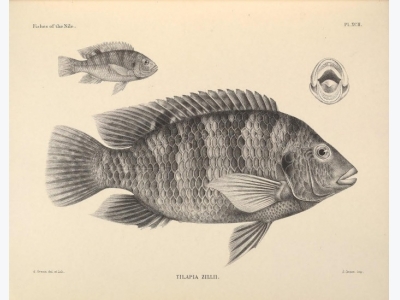7 Things You Didn’t Know About Tilapia
This little fish is making a big name for itself. Here are a few interesting facts about Tilapia that won’t likely come up at the dinner table.
 Are alternatives to fish oil really more sustainable?
Are alternatives to fish oil really more sustainable? A recent event which claimed that a new alternative source of omega-3s in aquafeeds is more sustainable than fish oil was “misleading”
 Nonprofit will develop and disseminate disease-resistant tilapia
Nonprofit will develop and disseminate disease-resistant tilapia New strains of Nile tilapia that are more resistant to disease and more effective at utilizing feed are being developed by WorldFish
 New soy-based feed developed for bluefin tuna aquaculture
New soy-based feed developed for bluefin tuna aquaculture A new soy-based aquafeed being developed for farm-raised bluefin tuna has been successfully tested in a project led by the Illinois Soybean Association
 Extensive wrasse use keys up ‘cleaner fish’ conservation questions
Extensive wrasse use keys up ‘cleaner fish’ conservation questions If there were a prize for the most unusual exhibit at this year’s Seafood Expo Global in Brussels, it might have gone to Wester Ross Salmon in the Scottish
 Biosecurity practices on fish farms need beefing up
Biosecurity practices on fish farms need beefing up Why does biosecurity matter? The aquaculture industry is expanding at a rapid pace due to intensive farming strategies and research improvements from the fields
 Salmon farmers limiting time at sea for biological risk mitigation
Salmon farmers limiting time at sea for biological risk mitigation Recirculating aquaculture systems (RAS) built on land are gaining in popularity, with a slew of modern indoor facilities popping up recently in Poland
 Algae-based aquafeed firms breaking down barriers for fish-free feeds
Algae-based aquafeed firms breaking down barriers for fish-free feeds At this year’s Seafood Expo North America, leaders from both the aquaculture and aquafeed industries spoke compellingly about the innovations being made
 Arctic char and crawfish processors snag BAP certification
Arctic char and crawfish processors snag BAP certification For the first time, both Arctic char and crawfish processors have achieved Best Aquaculture Practices (BAP) certification.
 The pink powder that could revolutionize aquaculture
The pink powder that could revolutionize aquaculture Biotech startup KnipBio is scaling up production of a single-cell organism as a sustainable aquaculture feed ingredient
 USSEC showcases IPA farming technology in China
USSEC showcases IPA farming technology in China The U.S. Soybean Export Council (USSEC) demonstrated the Intensive Pond Aquaculture (IPA) system to China’s fish-farming industry
 Ussec introduces intensive pond aquaculture technology to chinese aquaculture inductry
Ussec introduces intensive pond aquaculture technology to chinese aquaculture inductry USSEC recently introduced Intensive Pond Aquaculture (IPA) Technology to the Chinese aquaculture industry.
 Tilapia Fish Farming Information Guide
Tilapia Fish Farming Information Guide Fish is one of the species that is being farmed since centuries. Due to natural resources, fish became the best and cheapest animal protein consumed worldwide
 For Great Lakes aquaculture, it’s a tale of two countries
For Great Lakes aquaculture, it’s a tale of two countries Canada and the United States may be neighbors, but when it comes to aquaculture in the Great Lakes – Superior, Huron, Michigan, Ontario and Erie
 A warning and an improved PCR detection method for tilapia lake virus (TiLV) disease
A warning and an improved PCR detection method for tilapia lake virus (TiLV) disease A warning and an improved PCR detection method for tilapia lake virus (TiLV) disease in Thai tilapia farms
 The promise of In-Pond Raceway Systems, part 1
The promise of In-Pond Raceway Systems, part 1 As world population and seafood demand continue to increase, intensification of aquaculture is unavoidable while fisheries resources, land and freshwater
 The promise of In-Pond Raceway Systems, part 2
The promise of In-Pond Raceway Systems, part 2 This is thought to be a consequence of better control of feeding by personnel, adequate oxygen levels maintained inside the raceways, preventive baths
 Testing fish oil alternatives in red hybrid tilapia diets
Testing fish oil alternatives in red hybrid tilapia diets With the rising costs of fish oil (FO) and limited global supplies, the use of alternative lipid resources in aquafeeds, including tilapia feeds
 Fish producers benefit from humane slaughter techniques
Fish producers benefit from humane slaughter techniques Roughly 1 billion fish are farmed and slaughtered in the EU each year, according to Compassion in World Farming, an organisation that suggests most are killed
 In sea lice fight, salmon farmers phasing out hydrogen peroxide
In sea lice fight, salmon farmers phasing out hydrogen peroxide 2 years ago, Marine Harvest used 8 million liters of hydrogen peroxide to treat sea lice & amoebic gill disease at its salmon farms along the coast of Scotland
